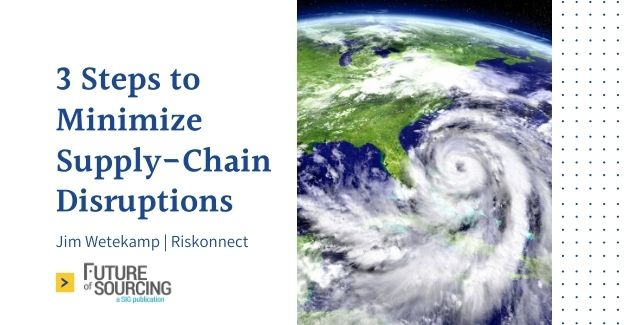With no foreseeable end date to supply chain disruptions, now is the time for organizations to examine the likelihood of interruptions and aim to get ahead of the problem before it takes hold says Jim Wetekamp, CEO of Riskonnect. He shares a three-step plan to build supply chain visibility, plan for various situations and the benefits of diversifying your supply sources.
Most businesses didn’t anticipate having to handle the supply-chain impacts of several disruptive forces at once: an ongoing pandemic, a severe crunch for talent and Russia’s invasion of Ukraine.
Pandemic-driven shortages are still in full swing. New COVID outbreaks in China are slowing the flow of goods into the U.S. The ongoing mass exodus of supply chain and logistics workers continues to make it difficult for companies to keep up with demand. Russia’s invasion of Ukraine compounds these challenges. Economic sanctions from Western countries are driving up global logistics costs and lead times, exacerbating supply shortages.
The odds of so many risk events coalescing are seemingly low. But the past few years have shined a spotlight on the interplay of risks. Every big risk event weakens you for any subsequent event, amplifying the damage and disruption.
What Could Come Next?
Europe is facing its worst migrant crisis since World War II as Ukrainian refugees flee to Poland and other neighboring countries. The rippling economic effects could tack onto current supply-chain pressures. The prospect of disruptive cyberattacks is also becoming more likely. Ransomware actors are focusing their attention on manufacturers’ supply chains, threatening to cripple already strained operations and undermine national security.
At the same time, climate change and an uptick in damaging extreme weather events are threatening supply-chain resilience. Coastal flooding due to rising sea levels can lead to port closures, facility shutdowns and other logistical challenges.
No matter what risk events lie in wait, there are ways to lessen the potential impact and speed your response time.
How to Act Now
There are three steps you can take today to bolster your supply-chain risk management capabilities.
1. Build Supply-Chain Visibility
Incomplete, scattered, or out-of-date information can leave you blind to what’s coming and flat-footed when disruptions hit. Companies often work with an array of procurement and enterprise resource planning (ERP) systems, each home to different pieces of supplier, product and transaction data. These disparate technologies limit teams’ view of the supply base, which hinders the ability to make fast and confident decisions.
Trustworthy data is table stakes for supply-chain risk management. Build visibility by getting all your supply-chain data – product quality, contracts, on-time delivery performance, supplier financial and cyber health, ESG metrics and more – in one place. Bringing all your information into one platform with relationship mapping capabilities gives you deep insight into supplier performance, potential risks and the impact each partner has on the organization. If a supplier is in poor financial standing, for instance, you can see your total risk exposure and quickly pivot before that supplier goes out of business.
2. Model Various Scenarios
If a major hurricane shuts down several key ports, how severe would the supply-chain interruptions be for your business? How quickly could you detect and respond to a cyberattack on your supply-chain operations? Could you handle both events if they happened at the same time? If you aren’t confident in your organization’s ability to withstand coinciding disruptions, now is the time to prepare.
Scenario planning is an invaluable tool to up your game. Play out various potential risk scenarios to understand the impact each would have on your organization. Assess your ability to respond to multiple events at once and choose appropriate mitigations. It’s critical to proactively look beyond daily risk exposures to prepare for more disruptive events and bigger abnormalities.
3. Diversify Your Supply Sources
COVID-19 highlighted the drawbacks of heavily relying on offshore supply-chain operations. Even still, companies’ reshoring efforts have been slow, and many supply chains still lean on distant supply sources.
Supply-chain resilience hinges on having a diversified portfolio of suppliers to tap in the event your primary relationships can’t deliver. If a port shutdown closes off a key supplier on the other side of the world, being able to identify and pull the trigger on an alternative supply source, possibly closer to home, is paramount. This will help protect the flow of goods when confronted by future pandemics, geopolitical issues and other major risk events.
The Interplay of Risks
Supply-chain hiccups are inevitable. What makes today’s landscape especially challenging is the interplay of major risk events, including the pandemic, talent shortage, war and more. There will be more disruption. Build up your supply-chain and risk management capabilities now so you’re ready for what could come next.









